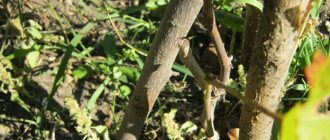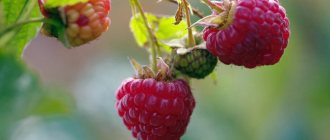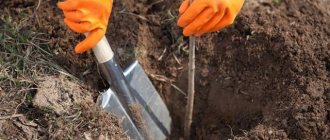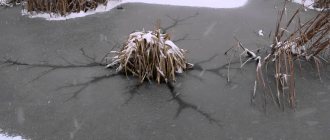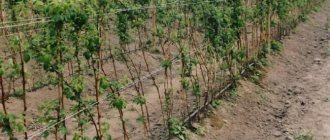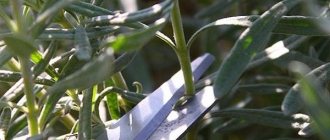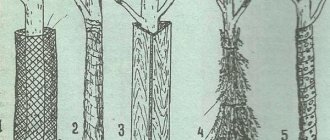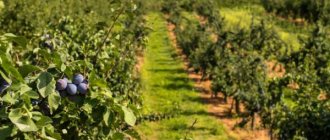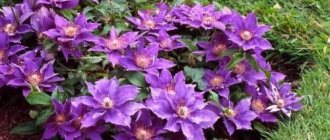How to ensure a comfortable winter for strawberries? What needs to be done to get an excellent harvest of your favorite berries next year? Today we will talk exactly about this. And a little more about feeding, pruning, the characteristics of remontant varieties and about growing this heat-loving crop in Siberia.
I know that many gardeners are attentive to signs. They watch the crimson sky and the birds flying away and base their work schedules on the site on this basis. But there is one more proven sign that everyone should know! Garden strawberries on the plot bring smiles to children and delicious desserts in the kitchen. Therefore, while working in the strawberry beds, let us remember this, let good thoughts and motives stimulate us.
Preparing strawberries for winter shelter
It is worth remembering that it is important to know not only how, but also with what and when to cover strawberries. Regardless of the chosen method of protecting plants from cold, it is advisable to carry out the following work in full.
But before sheltering, the following work needs to be done:
- Bush rejuvenation. It is worth removing overgrown long tendrils and old faded leaves. If the bush is too old, you can dig it up and plant a young bush in its place. This way we will immediately remove the threat: pests often accumulate on old bushes.
- Disinfection of the area. This is very simple to do: you need to loosen the soil. This way we will ensure free access of air to the root system of the crop and will not allow pests to overwinter under the soil layer.
- Fertilize the area. The land is fertilized exclusively with organic matter.
- Mulching the soil. Most often they mulch just before the onset of frost. If you cover strawberries with mulch ahead of time, the bushes will rot or decide that it’s time for them to grow. By the way, mulching often replaces covering the soil on which the crop grows with agrofibre.
- Install a small fence around the area. This is necessary so that the snow lingers in the garden bed. This means that the plant will be under reliable cover.
In the preparatory work I named some types of shelters. I’ll announce the entire list of things you can use to “wrap” strawberries so that they overwinter safely:
- Mulch from chopped herbs and branches;
- Lapnik;
- Straw;
- Unshredded branches;
- Agrofibre;
- Constructions made of film and reliable frame.
Of course, the snow is worth mentioning. But we can use it as a shelter only if it falls out.
Organic fertilizers
Organic fertilizers for strawberries can be very different. They need to be selected taking into account the specific plant variety and the climatic conditions in which it grows.
A replacement for mullein or chicken droppings is green fertilizers, for example, nettle tincture. To prepare, compact a large container 2/3 full with nettles and pour water to the top, leaving a gap for fermentation. If possible, add pieces of stale bread.
After 10 days, dilute the resulting tincture with water 1:10 and use it for root feeding of plants. Fertilizing with nettle absinthe improves the health of the strawberry plantation and gives the berries a refined flavor.
Between the rows, place cut bean green manure (for example, lupine), or any grass without seeds, sprinkled with sand or a thin layer of soil.
Yeasts are somewhat different from traditional organics; they are living, single-celled fungi. But they are also great for autumn feeding. Yeast contains:
- nitrogen;
- fats;
- proteins;
- carbohydrates.
All these substances are necessary for garden strawberries, both during fruiting and in preparation for hibernation. Yeast infusion brings important micronutrients, B vitamins and phytohormones to strawberries. To prepare the solution, take:
- yeast 100 g;
- warm water 2 l.
Dissolve the yeast in the water and add the liquid starter to a bucket of water (8 liters). Wait 5 hours and apply root feeding.
Cow or bird droppings
Cow manure or humus is used to mulch between rows and is added to holes during planting (replanting strawberries are replanted in the fall). The substance decomposes slowly, supplying the earth with the necessary nutrients for 2–3 years.
Cow excrement is rich in nitrogen, phosphorus, potassium and calcium. In terms of the composition of useful organic matter, they are much superior to the waste of other pets.
Unlike cow droppings, it is unacceptable to fertilize plants with dry bird droppings! This is a very active substance that can burn the root system and leaves.
An aqueous extract of bird droppings in a concentration of 1:30 is suitable for feeding garden strawberries. Before use, the liquid is kept for 2 days and poured into the grooves between the rows. With this method of application, the fertilizer gives strength to the plants and regulates the acidity of the soil. But excessive consumption of bird droppings increases the percentage of nitrates, which can adversely affect the quality of the berries.
In the video below, the gardener talks about how to use bird droppings to fertilize garden strawberries:
Mullein
The solution is used for root feeding of garden crops. The fertilizer is rich in nitrogen, phosphorus, potassium and calcium. Mullein is well absorbed by plants and has a beneficial effect on the composition of the soil.
To prepare mullein, fresh manure is poured with water in a ratio of 1:5, mixed thoroughly and kept for 2 weeks in a tightly closed container, stirring once a day. After 2-3 days, after the start of fermentation, the liquid is ready.
Before use, dilute the fermented mass with water 1:10 and fertilize the plantation. Do not pour more than 1 liter under the bush. Avoid direct contact of liquid with the leaf rosette.
Wood ash
The ashes of burnt wood, weeds and branches or stems of sunflowers are an effective microfertilizer. Ash is sprinkled on garden strawberry bushes and a water infusion is made to nourish the roots.
Recipe:
- ash 1 cup;
- water 10 l.
Apply root feeding with the solution, no more than 0.5 liters per bush. When using, stir the liquid so that the ash does not precipitate.
Ash is added to mullein and some solutions of mineral fertilizers, but such mixtures must be made strictly according to the recipe:
- mullein 1 l;
- wood ash 500 g;
- water 10 l.
Pour under the bush, no more than 1 liter per plant.
Wood ash is not only a nutrient, it also has the following effects:
- regulates soil acidity;
- promotes the decomposition of organic fertilizers;
- strengthens plant roots;
- fights harmful insects and diseases of garden crops.
Mulching a strawberry bed with dry ash is useful for preventing gray rot and protecting against pests. Do not use ashes from printing products and other household waste to feed plants. The presence of harmful dyes can adversely affect the health of plants and the quality of berries next year.
Sunflower, buckwheat or grass ash contains much more potassium than wood ash. The least useful elements are found in the ashes of spruce firewood and wheat straw.
The next video will talk about using ash to fertilize strawberries:
Slurry
The difference between mullein and slurry is the presence of bacterial infections in the latter. To prepare, cow manure is diluted with water in a ratio of 1:8 and left for 2 days. The method of application is similar to the mullein solution.
Organic fertilizers are necessary to stimulate growth and fruiting, but their overdose is harmful to plants. When growing strawberries on highly fertile soils, you should not add organic matter in full every year. After liquid feeding, water the beds thoroughly.
Trimming mustaches and transplanting strawberries into open ground
Speaking about bush rejuvenation, I mentioned mustache trimming. What kind of mustache is trimmed and why? Mainly longer mustaches are trimmed, as well as weak and secondary and third planar rosettes. They not only shade the bush and prevent the plant from receiving the required amount of ultraviolet radiation, but also “drain” all the juices from the plant. In addition, such pruning stimulates the growth and development of the root system.
They should be removed as close to the ground as possible. And at the same time, it is worth checking whether there is an underground part of the mustache that has managed to take root underground.
Pests
Strawberries have many enemies. They act almost the same way - they drink juices from bushes and berries, live in the garden bed, and reproduce in the soil near the flower bed and inside it. Let's look at the most dangerous of them.
Ticks
It is easy to notice the presence of strawberry mites on berries and leaves. Damaged fruits have an irregular shape and turn black in places. The microscopic insect eats berries, stems, and leaves at high speed. If you allow the mite to multiply for 1-2 seasons, the Victoria bed will gradually die. The pests will drink all the juices from the plant, leaving the gardener with withered leaves and empty ovaries.
Important! To get rid of ticks, Actellik is suitable.
Weevil
Colonies of insects with a long proboscis are found on Victoria in autumn and early spring. Among the external signs of their attack on the berry are:
- Holes on the leaves. Appear due to punctures in the nose while eating tops. If there are a lot of gnawed holes, take measures to destroy the pest urgently.
- Withered bushes. In this case, the strawberry has circular lesions around the root.
- Damaged petioles, pedicels. It was as if they had been cut off with a knife, but not completely with scissors.
Weevils live in the ground and lay larvae there. If you dig up the soil you can discover their habitat.
Important! Treatment of strawberries against weevils is carried out using Akarin, Iskra-bio.
Aphid
The most difficult thing to get rid of is aphids on Victoria. The female insect, similar to an egg but small in size, produces offspring 20 times per season. Colonies settle on the lower parts of plants. Most often they are found on the back of the leaf. If the pest is infested in a strawberry garden, the crop will look like this:
- Withered leaves
- Gall-like formations on green parts
- The tips of the shoots change
- The leaves are curling
- A colony of ants lives near a flower bed with berries.
Whitefly
The length of an adult whitefly reaches 5 mm. It is almost impossible to see the pest in adolescence due to the size and whitish color of the wings. Strawberry juice serves as a source of nutrition for them, and they suck it out in large quantities.
The danger of whitefly for garden strawberries is as follows:
- The plant dies due to disturbances in phytometabolism and lack of internal juices.
- The whitefly deposits liquid on the leaves, which provokes the development of fungus.
- The fungus disrupts the air flow to the leaves. They turn black and die.
- The growth of stems slows down.
Important! If the strawberry leaves turn white and are covered with a chalky coating, it means that the whitefly has laid eggs on the shoots.
Slugs
A mollusk that lives on land looks like a snail without a shell. The size of an adult individual approaches 5 cm. Slugs do not like green berries and young shoots. They prefer to settle in the garden strawberry bed closer to harvest. It is difficult to notice them during the day; they hide in the ground. They come out to feed at night, eating pink and red berries. This is interesting! Increased activity of slugs is recorded in humid, warm summers. If the weather is dry, the pest is almost never found in the beds.
Do I need to trim strawberry leaves in the fall?
Many gardeners do not recommend removing the entire above-ground part of the strawberry, otherwise the bush may die. And in another way, there are benefits from leaves: they retain snow and protect the bush from frost, and also provide the plant with nutrition.
You need to remove old dried leaves, as well as diseased ones. They are carefully CUT OFF from the stem, leaving a growth point. Under no circumstances should they be cut off so as not to damage the bush.
Benefits of cutting leaves in the fall:
- Pruning stimulates the growth of the root system, because the plant no longer needs to spend nutrients on the above-ground part.
- Insects hide in the leaves and if they are not cut off, then with the arrival of spring the pests become more active. Therefore, it is better to remove the larvae and the insects themselves along with the foliage on the eve of wintering.
Some people remove all leaves for the reasons listed above. But there are also opponents of this theory who present their own arguments. They say that pruning causes stress in strawberries and that after removing the leaves, the roots do not receive enough oxygen, because the leaves are the plant’s respiratory organ.
I never trim leaves because I'm lazy. The harvest is always good, there are no pests, despite the fact that I don’t even treat it with anything. But I have nothing to compare with. Perhaps if I cut the leaves it would be even better... I need to check. Perhaps this year I will make half of the plantation according to all the rules of autumn care and compare the results in the summer.
Strawberry pests
We recommend reading our other articles
- How to grow an apricot from a seed
- The best varieties of cherry tomatoes with descriptions and photos
- Broiler ducks
- The benefits and harms of cherries for humans
Pests that often plague strawberries include earthen and spider mites, aphids, strawberry-raspberry weevils, slugs, and snails. Bushes can also be affected by nematodes, small black mowers, alfalfa mowers, and strawberry sawflies.
Pests of strawberry leaves
Important!
Some pests, such as nematodes (strawberry, stem), are not eliminated by insecticides. To remove them from the site, it is necessary to replace the bushes with new, healthy ones. It is also advisable to change the soil if possible!
Processing strawberries in the fall involves the use of insecticides against pests. Since it is carried out after the harvest, you can use quite strong drugs that will certainly help get rid of annoying insects.
How can you feed strawberries?
You will be surprised if you find out that fertilizing the soil allows the crop to overwinter better:
- Fertilizers improve the composition of the soil;
- The earth becomes looser, and this is very important for the growth of the root system;
- The plant's resistance to pests and diseases increases.
Then it’s worth finding out what to feed your garden strawberries in the fall!
- Wood ash. In the form of a dry product 150g per 1 sq.m. land. In the form of an infusion (2 tbsp per 1 liter of hot water; boil for 15 minutes. Mix this infusion in 10 liters of water and apply).
- Vermicompost. Plant and water the soil, not the plants!!!
- Chicken droppings. 500g of dry litter is diluted in 10l of water. Infuses for 2-10 days. And then you can water it. But it’s better not to apply this fertilizer to the bushes.
- Humus. In dry form, humus is scattered between the bushes, and after 5-7 days the earth is loosened. In liquid - 1 kg per 10 liters of water is stirred. After 2 days you can water with this infusion.
- Bean green manure , lupine stems, and mown grass are crushed, laid out between the bushes and covered with earth. You can use liquid fertilizer made from grass and weeds.
These fertilizers will strengthen the plants and help them survive the winter.
Mineral fertilizers
The simplest way to feed with mineral fertilizers is complex preparations, for example: “Kemira autumn” or “Tsitovit”. Before adding mineral mixtures, carefully read the instructions on the package.
The most necessary components of feeding are potassium and nitrogen salts. They are used for dry and liquid fertilization and are certainly combined with watering the strawberry bed.
Potassium
The importance of potassium fertilizers for growing garden strawberries cannot be overestimated. Potassium prolongs the shelf life of berries, makes them sweet and very tasty.
A clear sign of a lack of potassium in the soil is the brown ends of the leaves and unusually sour strawberries. To fertilize, potassium salt is dissolved in water at a rate of 2 g per 1 liter and applied along the rows.
To feed the roots, take a mixture of 15 g (1 tbsp.) potassium salt and 20 g of nitrophoska, then dissolve in 10 liters of water. Nitrophoska is a rapidly soluble chemical compound that includes phosphorus, potassium and nitrogen. The resulting mixture is enough for 10 strawberry bushes.
Watch a video about applying a complex preparation that includes potassium, phosphorus and nitrogen:
Nitrogen
To replenish the soil with nitrogen, you need urea or ammonium nitrate. Nitrogen accelerates the growth of berries, gives a rich red color and improves the gastronomic qualities of strawberries. But, subject to the correct dosage of fertilizer.
Excess nitrogen will reduce the sugar content of the fruit. The main indicators of nitrogen deficiency are stunted and pale leaves, small fruits, and weak plant tendrils. To apply under the bush, urea is diluted in the proportions of 1 tbsp. l. per 10 liters of water, this is enough for 20 strawberry bushes.
A mixed solution is prepared from industrial and organic fertilizers:
- water 10 l;
- ash 1 tbsp.;
- mullein 1 l;
- superphosphate 2 tbsp. l.
Use to fertilize between rows at a rate of 10 liters per 1 square meter. m plot. Combined mixtures are prepared immediately before application to the soil.
Hydrogen peroxide is also used to fertilize garden strawberries. The extract effectively increases the level of oxygen in the ground air, which helps plants absorb nutrients. To prepare the solution, take:
- water 1 l;
- hydrogen peroxide (3%) 2 tbsp. l.
Use 200 ml per bush for root feeding.
Mineral fertilizers primarily affect the plants themselves, and do not improve the quality of the soil. In weak and depleted areas, it is recommended to combine mineral fertilizing with the addition of organic matter.
Compared to organic fertilizers, mineral fertilizers do not have an unpleasant odor and are more convenient to use. But their use requires strict adherence to recommended standards.
How to properly feed strawberries with boric acid
We talked about fertilizing. But there is another effective remedy - boric acid. It is very important for the quality, taste and aroma of berries.
How to properly feed the crop:
- In the spring (before flowering), the bushes are watered with a solution of water (10 l), boric acid and potassium permanganate (1 g each).
- For irrigation: water (10 l), ash (1 tbsp.), boric acid (2 g) and potassium permanganate (2 g).
- Foliar feeding: spray a solution of water (10 l) and boric acid (5 g).
- During berry ripening: water (10l), boric acid (2g), wood ash (100g), urea (20g), potassium permanganate (3g).
For root fertilizer, you can make the following solution: pour 1 cup of wood ash with 2 cups of boiling water and leave for 2 hours. Add to this tincture 2 grams of potassium permanganate (not a solution, but crystals), 3 grams of boric acid, 10 drops of iodine and pour 10 liters of warm, settled water. The principle of the fertilization process: 1,250 ml glass for one bush.
Very often I hear that boric acid is simply scattered over the soil. This is done exclusively in the fall to allow moisture (rain and snow to dissolve the acid). But experienced gardeners still advise using acid only in dissolved form.
Strawberry pruning
Having collected the last berries from the bushes, do not hesitate to prune the plants. The optimal time is the second half of July and the beginning of August. Mowing the foliage at a later date is not carried out, as there is a risk of damaging the fruit buds, as well as weakening the crop before the cold weather.
Cut the bushes, leaving shoots up to 8-10 cm high. Use pruning shears and sharp garden shears. Work carefully, trying not to damage the strawberry rosettes. Remove foliage from all bushes - healthy, sick, making sure to burn plant debris. It is not advisable to use cut leaves for compost, as they may contain pathogens of various infections.
Treating strawberries against pests in the fall
Our strawberries will have to survive the winter. This is a shocking environment for culture. But diseases and pests can feel quite normal. With the onset of warmer weather, our plants will be under threat. Weakened, they are unlikely to be able to bear it.
How to process strawberries:
- Processing time – end of harvest. For the regular one it is September-October, for the remontant one it is October-November.
- The bed is carefully cleaned and loosened. Dry and diseased leaves and tendrils that thicken the planting are cut off from strawberry bushes.
- Depending on the problem that the gardener most often encounters on his garden strawberry plot, the necessary preparations are selected. They process the soil and plants according to the instructions.
What drugs are these:
- "Topaz", "Bayleton". From powdery mildew, brown and white spotting.
- "Teldor." From black and gray rot.
- "Nitrophen". From fungal spores.
- Mixture: water (10l), copper sulfate (300g), lime (300g). From brown and white spotting.
- Insecticide "Metaldehyde". From pests, mainly from slugs and snails.
- “Fitoferm”, “Aktellik”, “Aktofit”, “Karbofos”. From ticks and aphids.
- "Aktara", "Aktellik", "Intavir". From beetles and weevils.
Sometimes, in order to completely get rid of pests, you need to completely renew both the soil in the garden bed and the plants.
Autumn work for a summer resident
This informative article will tell you about how to care for strawberries in the fall, in addition to fertilizing with fertilizers. The more time a person devotes to berry crops, the stronger and more productive the bushes will be next year.
After harvesting the berries, the strawberries become overgrown with weeds, the bushes become spotted and often dry out for unlucky summer residents. But the pathogens are not sleeping now, further weakening and inhibiting the plants, because at the time of fruiting it is not recommended to weed the ground and sprinkle chemicals.
The task of strawberries during this period is not only to grow young leaves and lay flower buds, but also to develop many tendrils.
At the end of summer, mother plants need care, so the gardener must tidy up the bed.
Complete care of strawberries should include important measures:
- weeding and loosening the soil;
- preventative pruning of bushes;
- watering and fertilizing;
- spraying against pests and infections.
Experienced gardeners strongly advise not to put off this work and to take care of the plants as early as August, with the only exception being remontant strawberries. It can be improved in September, when fruiting is completed and the first frost is approaching.
Fertilizing strawberries with manure
Strawberry bushes fertilized with manure become stronger and produce a better harvest. How to properly apply manure to the garden bed:
- Before autumn digging (or deep weeding), manure is scattered around the site. When the fertilizer dries, the soil is dug up along with it. This is how manure is incorporated into the beds.
- Rotted manure is introduced in the form of a “chatter” into the holes when replanting plants.
Strawberries are mainly planted in the spring. But in the fall you can fertilize bushes transplanted to a new location in the same way.
Transplanting strawberries in autumn
There is no need to replant old Victoria bushes. Young trees up to two years old are planted or new rosettes are planted. This event is aimed at rejuvenating the strawberry bed. At its core it is reproduction. For these purposes, they use their own planting material or purchased from a nursery. To root rosettes, select bushes that have produced a smaller harvest this season. Strawberries are unique - in one season the bush devotes resources to either vegetative or generative reproduction (fruiting). Leave one stolon on the bush. As soon as it becomes possible to pin the first order rosette to the ground, pinch the tip of the whisker. When the baby takes root, it can be removed from the soil and transplanted to a new place. Some varieties do not produce stolons. They are propagated by particulation or division of the bush. To do this, the socket is removed from the ground and divided into 2-3 parts. Then they are planted in a new place.
Remember! The best planting material is first order rosettes.
Autumn transplanting of strawberries is carried out at different times. For the Middle Zone, it is better to complete the procedure in mid-September; in the South, you can plant until the end of the first ten days of October. In regions with a harsh climate, it is more advisable to transplant at the end of summer. Such timing will allow the young shoots to fully take root before the onset of cold weather. The transplant is carried out as follows:
- shorten the root lobe of the seedling to a length of 10 cm;
- dip the roots in garlic infusion or a weak solution of potassium permanganate to disinfect;
- prepare a clay mash based on a growth stimulator solution. Immediately before planting, dip the root lobe in mash;
- on the prepared bed, form holes in increments of 20-40 cm. The distance between rows is 40-60 cm;
- prepare a nutrient substrate from a mixture of fertile soil with a bucket of mature compost.
- Place the moistened substrate on the bottom of the hole. Place the seedling on a mound so that the heart is level with the surface of the ground;
- add the substrate, compact it, water it generously;
- Be sure to mulch the soil with peat or humus.
Care for transplanted seedlings is carried out according to the standard scheme.
No additional fertilizing is required.
Pruning, feeding and caring for remontant strawberries
Strawberries, which produce crops several times a year, require more careful care. For example, you will need:
- Watering. After planting the plants every day for 5 days. Then - 3 times a week. In dry times - every other day.
- Feeding. The first feeding is in the last days of May with a weak urea solution (1g per bucket of water). The second feeding is in June, during the active formation of the peduncle, water the beds with mullein (1 to 10). These are mandatory supplements. In addition to them, during the season the plants should be fertilized 5-8 times with special mineral fertilizers, such as Kemira Lux, Crystalline Solution.
- Pruning of remontant varieties can be carried out both in spring and autumn. After fruiting, all the lower leaves are removed from the bush, only the upper ones remain. In autumn, the mustache is also trimmed and old and dry leaves are removed.
- Mulching. This is one of the important conditions for caring for plants. This way you can retain moisture and protect the stem of the bush from freezing or overheating.
If you live in a cold region where remontant strawberries require shelter, then pruning should be done in the autumn. This is done as follows: after harvesting the entire crop, the lower leaves are removed from the bush, trying not to touch the upper leaf blades, because it is in their axils that the fruit buds are laid, from which the fruits will form next season.
Another important condition in caring for this crop is renewing the plantings every 3 years!
Advice from experienced gardeners
Experienced gardeners recommend taking into account several important nuances when preparing strawberries for winter.
Subtleties of processing:
- For the first time before winter, trim only one ridge of the plant, leaving the rest unchanged (this will help determine how the plants overwintered better);
- Fertilizers containing chlorine and large amounts of nitrogen should not be used in the fall;
- It is not recommended to replant into frozen ground (if it was not possible to do it on time, it is better to postpone the procedure to spring);
- As the snow falls, throw it with a shovel onto the bed with strawberries (it will serve as additional cover).
More tips from experienced gardeners can be found in the following video:
Pre-winter processing of strawberries will allow the crop to wake up faster in the spring. It will contribute to the appearance of a high and high-quality harvest in the summer, since growth buds are formed in the fall.
0
0
Copy link
Advice from experienced gardeners on how to prepare strawberries for winter in Siberia
Autumn is a good time to transplant or plant strawberries. It is easy to propagate vegetatively. In the conditions of the short Siberian summer, early-ripening varieties are grown and they begin to prepare them for winter immediately after harvesting.
For Siberia, experienced gardeners advise carrying out the following work:
- Start growing strawberries by choosing a suitable variety that will grow well in a given region. Therefore, care for the crop will be minimal. The plant will be less sick. Early ripening varieties are relevant for Siberia.
- You should start preparing the bushes immediately after the last harvest has been harvested.
- In early August, the bushes are put in order: the old mulch is removed from under them, the mustache and dry leaves are cut off. It is important to remove the flower stalks as well; this year they will not have time to produce a harvest, but the bush will weaken because of them.
- The bushes are fed.
- Before frost begins, the beds are watered.
- As a rule, you can start covering the beds in October.
These measures will help the plants go into winter stronger. This means they will overwinter and give us a harvest at the beginning of summer.
Was the article useful and are you ready to share it with your friends? Perhaps you want to add your experience to the topic? I will be sincerely grateful to you for this!
Features of preparing different types of strawberries for winter
Regular and remontant strawberries have their own characteristics that need to be taken into account when holding autumn events. Regular varieties stop bearing fruit quite early, while remontant varieties continue to bloom until frost. Preparation for winter must be carried out taking into account the life cycle of plants.
Regular
After pruning, fertilizing and pest control have been carried out, it is time to prepare for winter. The bushes winter well under the snow, but the gardener cannot know in advance how snowy the winter will be. To be on the safe side, it is better to mulch the strawberries with plant materials.
The ideal option is the use of pine needles. The needles do not stick together, do not absorb excessive amounts of moisture, and repel mice. If it is difficult for you to get spruce branches or pine litter, use compost, humus, and straw for covering. Some people install arcs over the bed, which are then covered with spunbond.
On a note! For covering procedures, you should definitely wait for frost; low temperatures at the beginning of winter will serve as a kind of hardening for the strawberries and the bushes will withstand wintering more easily.
Planting strawberries in autumn
Remontantnaya
Remontant varieties of strawberries require more attention and care. If they are not properly prepared for winter, the harvest next season will be very poor. Such strawberries should go into the winter saturated with moisture, so they need moisture-recharging watering. Water the bushes regularly, with warm water, in the morning or evening.
You need to be prepared for the fact that some of the actively fruiting plants will die off due to heavy load and you may need to replant young bushes. The best time for this is August. Until the frosts, it is necessary to monitor the plants and pick off all flower stalks until the berries are under the snow. Without a mulch layer, it is difficult for a crop of remontant varieties to survive the winter. Use the same mulch for it as for conventional varieties: spruce spruce branches, pine needles, straw.
When to replant strawberries in the fall
Preparing strawberries for winter: video
Disease prevention and pest control
Garden strawberries are often affected by fungal and other diseases, and various pests also do not bypass them. Timely treatment in the fall will prevent the appearance of insects and avoid infections.
On a note! It is recommended to dig up diseased bushes and burn them along with leaves and shoots.
For prevention use:
- insecticides Alatar, Actellik, Karbofos;
- biological products Fitoverm, Aktofit;
- infusion of tomato tops (for 10 liters of boiling water - 1-2 kg of tomato shoots and leaves);
- dandelion infusion (1 kg of herb per bucket of hot water).
The remedies listed above help against strawberry mites, weevils, and aphids.
To prevent fungal infections, it is recommended to spray the plantings with an infusion of leaves and stems of horse sorrel (in a bucket of water - a bucket of sorrel leaves, infuse for 3 days), with a solution of brilliant green (12-15 drops per 10 liter bucket of water). Do not forget about treatments with Bordeaux mixture, copper oxychloride, Alirin, Trichodermin, and mustard powder solution.
Loosening and mulching
The row spaces on the ridges are cleared of weeds and must be loosened. Avoid overgrowing of plantings, as this leads to weakening of the crop and the occurrence of various infections on strawberries. Loosen carefully so as not to damage the plant roots located close to the surface of the earth.
Mulching greatly simplifies maintenance. The space between the bushes is sprinkled with peat, Christmas tree and pine needles, sawdust, and mown grass.
